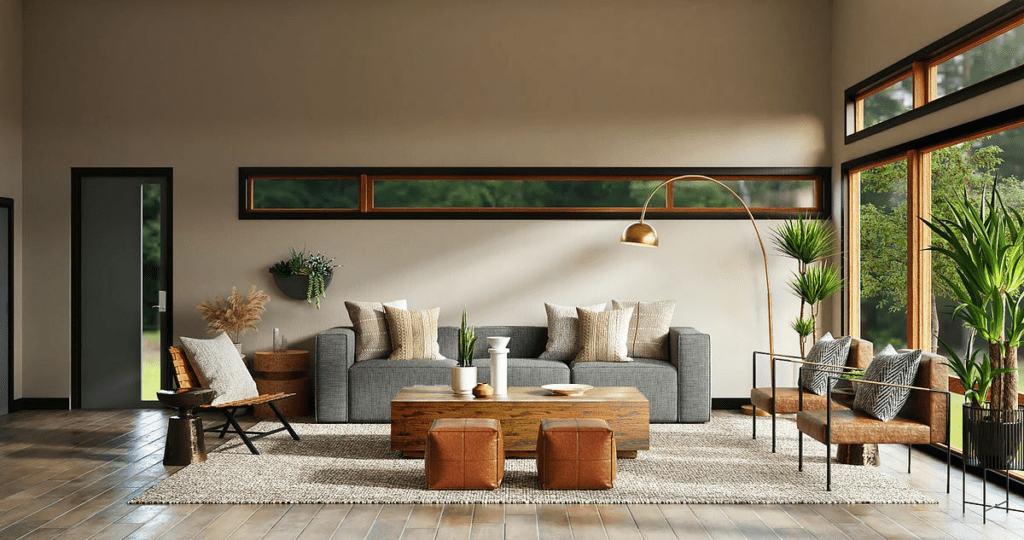Bringing fresh pieces into your home can be challenging. How do you seamlessly integrate new furniture with your current collection to create a cohesive look? There are several factors to consider, including color schemes, design styles, patterns, and overall balance. This process might seem complex at first glance.


Read also: How to Measure Bar Stools?
Table of Contents
ToggleColor Coordination: The Foundation of Harmonious Furniture Mixing
Color plays a vital role in creating a cohesive look when mixing furniture pieces. Start by identifying the dominant colors in your existing decor. These serve as your base palette. From there, you can introduce new furniture that either complements or contrasts with this palette.



For a harmonious look, choose new pieces in similar hues or shades of your existing colors. This creates a seamless blend throughout the room. If you prefer a bolder approach, opt for complementary colors – those opposite on the color wheel. For example, if your current furniture features cool blues, consider adding accents in warm oranges or yellows.
Don’t shy away from neutrals. They act as excellent bridges between different color schemes. A beige sofa can tie together a room with both warm and cool tones. Similarly, gray pieces can soften the contrast between bold colors.
Remember the 60-30-10 rule: 60% of the room should be your dominant color, 30% your secondary color, and 10% an accent color. This balance ensures visual interest without overwhelming the space.
Lastly, consider the room’s lighting. Natural and artificial light can significantly affect how colors appear. Test potential new pieces in your space at different times of day to ensure they blend well under various lighting conditions.
Style Fusion: Mixing Different Furniture Designs
Blending furniture styles can create a unique, personalized space that tells your story. The key is finding common elements that tie different styles together.



Start by identifying the dominant style in your current decor. This could be modern, traditional, rustic, or eclectic. Once established, you can introduce pieces from other styles that share similar characteristics.
For example, if your space is primarily modern with clean lines and minimal ornamentation, you might introduce a traditional piece with simple, elegant details. The shared simplicity creates a bridge between the two styles.
Consider the scale and proportion of your furniture. Pieces from different eras can coexist if they’re of similar size. A bulky Victorian armchair might overpower a sleek, modern sofa, but a streamlined antique side table could complement it beautifully.
Materials and finishes can also unify diverse styles. A modern glass coffee table can work well with a rustic wooden sideboard if both have similar metal accents or finishes.
Don’t forget about transitional pieces – furniture that blends elements of traditional and contemporary design. These can serve as excellent mediators between contrasting styles.
Lastly, use accessories to tie everything together. A contemporary lamp on an antique dresser or vintage throw pillows on a modern sofa can create a cohesive look across different furniture styles.
Pattern Play: Balancing Prints and Textures
Incorporating patterns and textures adds depth and interest to your furniture arrangement. The trick is to balance bold prints with more subtle designs to avoid visual chaos.



Start with a focal point – this could be a patterned sofa, a textured rug, or boldly printed curtains. Use this as your anchor and build around it with complementary patterns and textures.
When mixing patterns, vary their scale. Pair large, bold prints with smaller, more intricate designs. This contrast prevents patterns from competing for attention. For instance, a large floral print on a chair can be balanced with small geometric patterns on throw pillows.
Consider the rhythm of patterns in your space. Distribute them evenly throughout the room to create a sense of balance. If you have a patterned armchair on one side of the room, echo that with patterned curtains or artwork on the opposite side.
Textures are equally important in mixing furniture. They add tactile interest and can soften the visual impact of patterns. A smooth leather sofa can be paired with a nubby wool throw and silk pillows for a rich, layered look.
Don’t forget about solid colors. They provide necessary breaks between patterns and allow the eye to rest. A solid-colored piece of furniture can serve as a neutral backdrop for more boldly patterned accessories.
Finally, unite different patterns and textures through color. Ensure that the various prints and materials in your space share at least one common color to create a cohesive look.
Balancing Act: Creating Visual Harmony in Your Space



Achieving balance in your furniture arrangement is crucial for a harmonious and inviting space. This involves considering both the physical and visual weight of your furniture pieces.
Start by establishing a focal point in the room. This could be a fireplace, a large window, or a statement piece of furniture. Arrange your furniture to highlight this focal point, creating a natural flow in the room.
Consider the principle of symmetry. While perfect symmetry can feel formal, a loosely symmetrical arrangement often feels balanced yet relaxed. For example, you might have matching side tables on either side of a sofa, but with different lamps or decor items.
Pay attention to the height of your furniture. Varying heights create visual interest and prevent the eye from staying at one level. Mix tall bookcases with lower seating, or use artwork and plants to draw the eye upward.
Distribution of furniture is key. Avoid pushing all furniture against the walls, which can make a room feel empty in the center. Instead, create conversation areas by floating some pieces away from walls.
Balance heavy pieces with lighter ones. If you have a large sectional sofa on one side of the room, balance it with a couple of armchairs and a substantial coffee table on the other side.
Consider the negative space – the empty areas in your room. These are as important as the furniture itself. Too much furniture can make a room feel cluttered, while too little can make it feel sparse. Aim for a comfortable balance.
Lastly, think about the function of the room. Ensure your furniture arrangement supports the room’s purpose, whether it’s for relaxation, entertainment, or work. A well-balanced room is not just visually pleasing but also practical and comfortable to use.
Personalizing Your Space: Incorporating Meaningful Pieces



While following design principles is important, your home should ultimately reflect your personality and experiences. Incorporating meaningful pieces into your furniture mix adds depth and character to your space.
Start by identifying items that hold special significance to you. These could be family heirlooms, souvenirs from travels, or artworks that resonate with you. Consider how these pieces can be integrated into your existing furniture arrangement.
Don’t be afraid to showcase unique or unconventional items. An antique trunk could serve as a coffee table, or a vintage ladder could become a bookshelf. These unexpected elements add interest and spark conversations.
Create vignettes that tell your story. Group related items together on a shelf or side table. For example, display a collection of ceramics from your travels alongside photos and books about those places.
Balance personal items with your overall design scheme. If a meaningful piece doesn’t quite fit your color palette, consider repainting or reupholstering it to blend better with your existing furniture.
Rotate your personal items seasonally or periodically. This keeps your space feeling fresh and allows you to enjoy all your meaningful pieces without cluttering your home.
Remember, these personal touches are what transform a well-designed room into a home that truly reflects you and your experiences.
Conclusion
Mixing and matching furniture is an art that combines practicality with personal expression. By focusing on color coordination, style fusion, pattern play, visual balance, and personal touches, you can create a space that is both aesthetically pleasing and uniquely yours. Remember that there are no strict rules – trust your instincts and choose pieces that resonate with you. Experiment with different combinations, and don’t be afraid to adjust your arrangement over time. Your home should evolve with you, reflecting your changing tastes and experiences. With these guidelines in mind, you’re well-equipped to create a harmonious and inviting living space that tells your story and welcomes both you and your guests.
FAQs
What color furniture goes together?
Choose a dominant color, a primary color, and accent colors. Then, use the 60-30-10 rule – allocate 60% of the room’s color to the primary color, 30% to the secondary color, and 10% to accent colors. This balanced distribution helps maintain visual harmony even when mixing different furniture styles.
Does all the furniture have to match?
Despite the growing trend of mismatched furniture in recent years, we know some people prefer uniformity. But if you’re looking for a middle ground, you don’t necessarily have to match your entire furniture set but can still incorporate a few matching pieces throughout your space.
What color furniture matches everything?
Since neutral colors are designed to pair with everything, the only colors you need to worry about coordinating are the brighter hues. For example, consider decorations and furniture in hues like turquoise, navy, seafoam, or mint if your walls are pastel blue.






